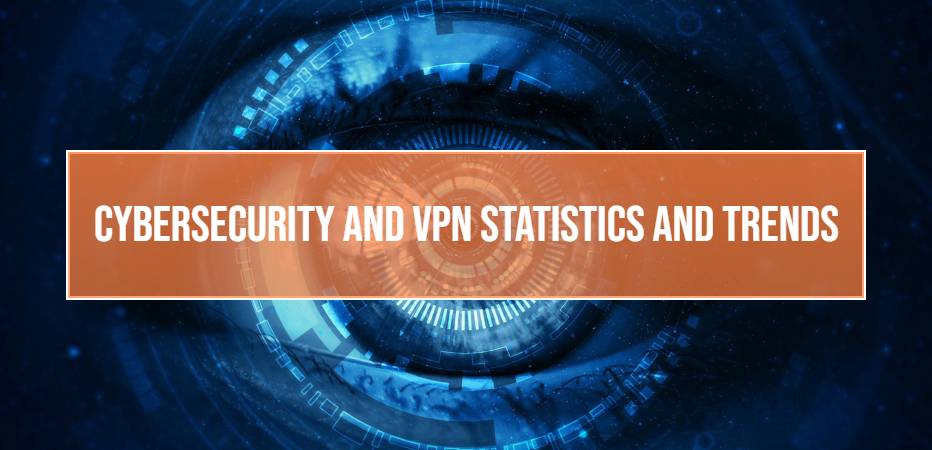Cybersecurity and VPN Statistics
Jessica Williams | Last Updated:

VPN Use and Cybersecurity go hand in hand. With Cybersecurity becoming a growing concern for many individuals, businesses and organisations, trends heading into 2024 show an increase in VPN use to combat cyber security threats.
Current Cybersecurity Landscape
The changing trend in the cybersecurity landscape during 2024 suggests a growth in cybersecurity threats and breaches and suggests a lack of preparation from many businesses.
- 2021 was marked as a year of accelerated malicious activity across victims and targets. (Symantec)
- 43% of businesses were a victim of cybersecurity breach in 2018. (Cyber Security Breaches Survey 2021).
- VPN market has increased by 23% during 2021, with ExpressVPN and NordVPN the worlds two largest retail providers. (Symantec)
- On average, 24,000 hazardous mobile apps are blocked every day. (Symantec)
- 41% of companies have over 1000 sensitive files open to the public (Varonis)
- 30 million personal records were stolen from Facebook in 2020. (Symantec).
- The average cost of losing sensitive information is approximately $4 billion. (Cloud Mask)
Risks Of Cybersecurity
Deemed to be a year of increased cyber threat, 2024 is set to be the year where cyber criminals become more advanced in their activity. The risk of cybersecurity not having proper security has greater damaging effects than ever.
- It is predicted that a business will fall victim to a ransomware attack every 14 seconds in 2021. (Cybersecurity Ventures).
- Identify theft and persona spoofing on online chat rooms such as Omegle has become commonplace.
- The biggest risks for users and businesses in 2019 is data leaks. (Heimdal Security)
- The risk of having weak cybersecurity can lead to a breach of confidentiality, identity theft and detrimental data breaches. (Mazarsledger)
- Since 2016, there has been a 54% increase in mobile malware variants. (Symantec).
- In 2018, there were 24,291 reports of phishing incidents with November being the most profitable month for scammers
Costs of Poor Cybersecurity
As cyber threats continue to grow, so do the costs in fixing the damage. Those who lack efficient cybersecurity may fall victim to detrimental costs.
- Potential economic loss caused by cybersecurity incidents can be up to $29 billion per year for Australian businesses. (Frost & Sullivan, Microsoft).
- In 2018, worldwide cybersecurity spending reached $96 billion. (Gartner)
- According to Ponemon Institute, the total cost of a successful cyber-attack is over $5 million. (Ponemon Institute).
- 40% of cybercrime incidents are costing Australian businesses and 2/3 of these businesses are unable to recover these costs. (Cyber Aware. 2017).
- Recent trends have shown an increase in greater and more extensive breaches, leading to greater cybersecurity costs. (Datafloq).
The Effects of Weak Cybersecurity
The effects of weak cybersecurity can be detrimental to businesses. These effects can have seriously damaging for companies, which may cause reputational and loss of consumer base.
- Since 2013, there have been 3.8 million records stolen from breaches every day. (Cubersecurity Ventures).
- There has been a 600% increase in attacks against IoT devices from 2016-2017, (Symantec)
- 1 in 13 web requests lead to malware. (Symantec).
- PDF files are the most common file type targeted by insider threats. (Cisco).
- Mobile devices are the hardest to protect from cybercrime. (Cisco).
Cybersecurity Predictions for 2024
As cybercrime continues to grow and become more extensive, the trends in 2020 explore the path in which cybersecurity will move towards in hope to combat the growing cybercrime.
- Zero trust is maturing into digital trust. (Dimension Data).
- There will be 6 billion internet users by 2022 and more than 7.5 billion users by 2030. (Cybersecurity Ventures).
- Organisations are focusing on cloud-based security platforms. (Dimension Data).
- A growth in risk profiling is expected in 2019 to prevent potential risks. (Dimension Data).
- It is predicted that cybercrime will cost the world $6 trillion annually by 2021. (Cybersecurity Ventures).
- Global spending on cybersecurity will exceed $1trillion over the next 5 years. (Cybersecurity Ventures).
VPN Usage and Current Trends
There is a strong correlation between VPN use and cybercrime. By utilising VPN’s, it makes it more difficult for cyber criminals and third parties to track your online activity.
- There has been a 165% growth in VPN use in 2021.
- Asia and the Middle East continue to dominate the VPN market.
- The top 3 countries of most VPN use include, Indonesia, Thailand and China.
- In 2019, it is estimated that there is $23.60 billion in the VPN market worldwide. (Go-Globe).
Reasons for VPN Use
VPN’s are seeing a growth in sue by individuals and this growth trend will continue through 2024.
- 50% of people using VPN’s use VPN’s to access restricted entertainment content. (Go-Globe).
- 77% of VPN users are buying digital content each month.
- 34% of users utilise VPN’s to access social networks or news services.
- Countries with limited internet freedom have a higher percentage of VPN users.
- Almost 30% of VPN use is used for streaming content, specifically accessing Netflix.
- VPN use is predicted to increase in 2021 as users want greater online privacy. (Fast Company).
VPN Use and Cybersecurity
Whilst VPN’s are mostly used for accessing entertainment and content, VPN’s can also be used as cybersecurity as an additional level of safety for online users.
- An increase in cyber crime had led to the increase in VPN use.
- Data privacy has driven up VPN use.
- 93% of IT professionals report challenges with ensuring data privacy.
- There is a current trend of growth in VPN use due to public awareness and cybercrime.
Categories: Statistics